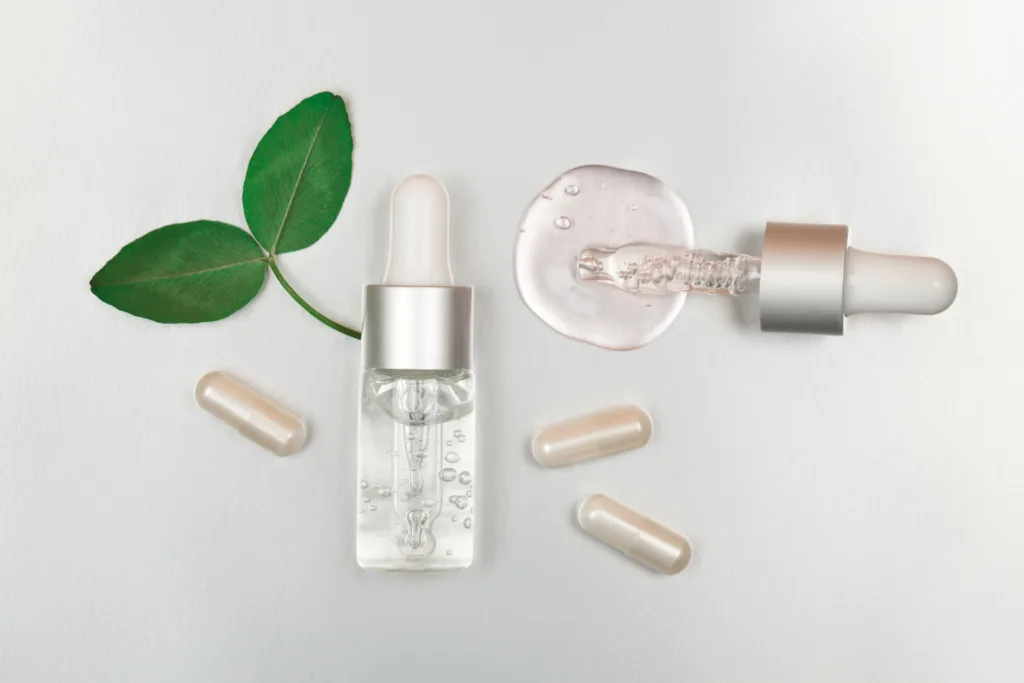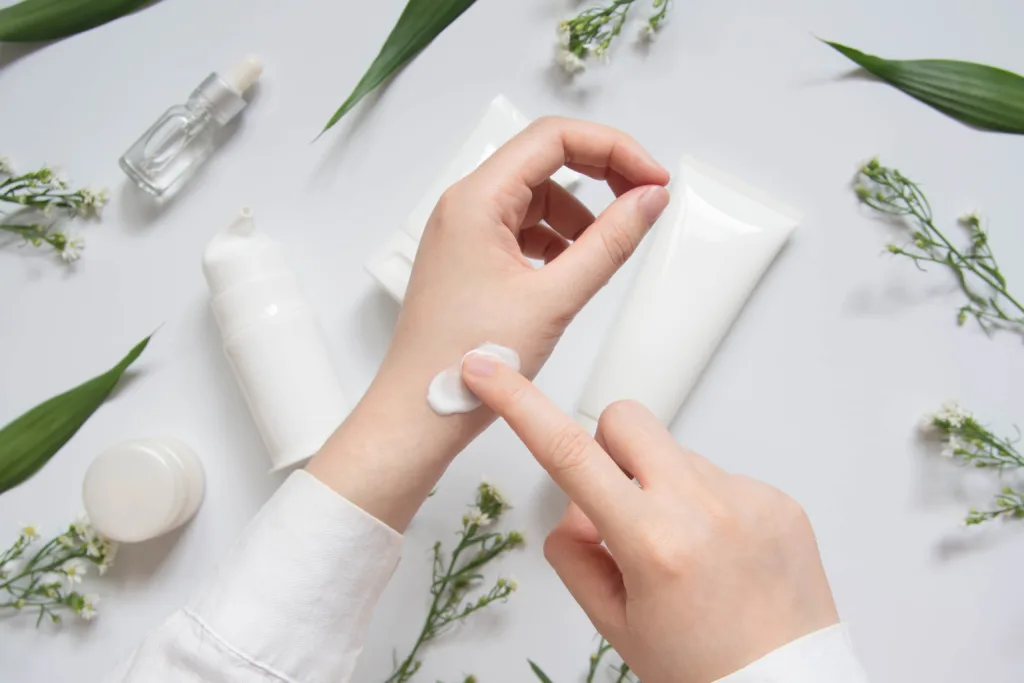
Both azelaic acid and niacinamide are effective ingredients for addressing various skin concerns, leaving you with a clearer, calmer, and more radiant complexion. But the real magic happens when you combine them.
When used together, these ingredients can synergistically amplify their benefits, taking your skincare routine to a new level!
We’ll explore the specific actions of each ingredient on its own, from managing acne breakouts to tackling stubborn hyperpigmentation. Then, we’ll discover the secrets of their combined power, revealing how their collaboration can effectively target multiple concerns simultaneously.
Of course, incorporating these ingredients correctly is key. We’ll share best practices for using azelaic acid and niacinamide in your routine to maximise their positive effects without irritating. Patch testing is crucial, so we’ll discuss its importance and how to tailor these ingredients to your unique skin needs. After all, everyone’s skin is different, so customisation is key!
What is azelaic acid?
Azelaic acid is a naturally occurring dicarboxylic acid with a range of benefits for skin health. Found in grains like wheat, barley, and rye, it is known for its anti-inflammatory and antimicrobial properties, making it an effective ingredient for treating various skin conditions.
Azelaic Acid Properties
Azelaic acid works through several mechanisms to improve skin conditions. It has antimicrobial properties, which help reduce the growth of bacteria such as Propionibacterium acnes and Staphylococcus epidermidis, which can infect skin pores and contribute to acne.
Additionally, azelaic acid is known to inhibit follicular keratinisation, which helps prevent the formation of comedones (clogged hair follicles) that can lead to acne lesions.
Azelaic acid also exhibits anti-inflammatory actions, which can reduce swelling and redness associated with various skin conditions. Moreover, it inhibits the enzyme tyrosinase, which is necessary for melanin production. By doing so, azelaic acid can help treat hyperpigmentation and even out skin tone, making it beneficial for conditions like melasma or post-inflammatory hyperpigmentation.
What is Niacinamide?
Niacinamide is a form of vitamin B3 essential for maintaining skin health. It works as an antioxidant and is known for improving the skin’s barrier function, reducing the appearance of blemishes, and helping with skin hydration.
Niacinamide Qualities
Niacinamide works in multiple ways to benefit the skin. Topically, it has been shown to increase the levels of NADP (nicotinamide adenine dinucleotide phosphate), which in turn stimulates keratinocyte differentiation, leading to a strengthened skin barrier and improved skin texture.
It also plays a role in reducing inflammation, which can help with redness from various skin conditions such as eczema, acne, and rosacea.
Niacinamide also acts as an antioxidant, protecting the skin from environmental stressors such as sunlight, pollution, and toxins. Moreover, it has the ability to boost collagen production, which can improve skin texture and smoothness and help reduce the appearance of fine lines and wrinkles.
Can You Use Azelaic Acid and Niacinamide Together?

Yes, you can absolutely use azelaic acid and niacinamide at the same time! In fact, combining them can be a powerful way to boost your skincare routine and target a variety of skin concerns.
Below, we will further explore each ingredient’s role and how they amplify each other’s benefits.
How do Azelaic Acid and Niacinamide Work Together?
While both azelaic acid and niacinamide offer impressive individual benefits for the skin, their true magic lies in the powerful synergy they create when used together.
Sebum Control
Azelaic acid targets the root cause of oily skin and acne by normalising sebum production through its impact on androgen receptors. At the same time, niacinamide’s role is to directly inhibit enzymes involved in sebum formation. Together, they effectively regulate sebum levels and reduce breakouts associated with oily skin.
Smooths Skin
Azelaic acid promotes proper differentiation, ensuring healthy skin cell development and preventing the accumulation of dead cells that can clog pores and lead to blemishes. Alongside this, niacinamide supports the formation of a strong skin barrier through its role in keratinocyte differentiation. This combined action effectively regulates cell processes, ultimately resulting in smoother and clearer skin.
Combats Inflammation
Both azelaic acid and niacinamide work together to combat inflammation in various skin conditions. Azelaic acid suppresses pro-inflammatory pathways and activates anti-inflammatory mechanisms, while niacinamide reduces inflammatory proteins and strengthens the skin’s barrier function. This combined action offers significant relief for inflammatory conditions like rosacea and acne.
Targets Hyperpigmentation
Azelaic acid inhibits tyrosinase, an enzyme key for melanin production, leading to lighter pigmentation. Niacinamide complements this action by regulating melanocyte activity and interfering with melanosome transfer, further reducing melanin production. This combined effect results in a more even and radiant skin tone.
Protects Against Environmental Stressors
The synergy extends beyond visible concerns, offering valuable protection against environmental damage. Azelaic acid acts as a shield against free radicals with its antioxidant properties. Niacinamide complements azelaic acid by providing its own antioxidant activity, further strengthening the skin’s defence against environmental aggressors. Together, they offer a fortified barrier against oxidative stress, contributing to healthier, younger-looking skin.
How to Layer Azealic Acid and Niacinamide
To effectively layer azelaic acid and niacinamide, follow the rule of applying products from thinnest to thickest consistency.
Start with the lightest product, usually a niacinamide serum, followed by a moisturiser, and finish with azelaic acid if it’s in a heavier cream form (if your azelaic acid is a lighter, water-based gel, applying it before moisturiser is generally recommended as it allows for better penetration and absorption).
This layering technique ensures maximum absorption of the active ingredients without causing unnecessary heaviness or product piling on your skin.
- Cleanse your skin: Start with a gentle cleanser to remove any impurities or makeup from your skin, making it ready to apply skincare products.
- Apply toner (optional): If you use a toner, apply it after cleansing as per your usual skincare routine.
- Apply niacinamide: Once your skin is clean (and toned, if applicable), apply a niacinamide serum or product. Niacinamide is typically lighter in consistency. Use gentle, upward motions to apply and allow it to fully absorb into your skin.
- Wait a moment: Give the niacinamide a few minutes to penetrate your skin. This can help prevent pilling and ensures that each product is effectively absorbed.
- Apply azelaic acid: After the niacinamide has absorbed, apply your azelaic acid product. Azelaic acid can sometimes have a thicker, creamier texture, so it makes sense to apply it after the lighter niacinamide serum.
- Moisturize: Finish with a moisturiser to lock in hydration and the active ingredients. If you’re doing this routine in the morning, follow up with broad-spectrum sunscreen to protect your skin from UV damage.
Skin Irritation and Patch Testing
Azelaic acid and niacinamide are generally well-tolerated by most, but like any active ingredient, some people may experience irritation. If you have delicate or sensitivity-prone skin:
- Conduct a patch test by applying a small amount of the product to a discreet skin area, such as behind the ear or on the inside of the forearm.
- Wait 24 hours to observe any signs of irritation or sensitivity, like redness, itching, or blistering.
Tailoring Your Approach: A Skin Type-Specific Guide

Now that we know the strengths of azelaic acid and niacinamide, let’s take a look into how you can leverage these powerful ingredients based on your unique skin type:
Oily & Acne-Prone Skin
If you’re battling oily skin and acne breakouts, azelaic acid and niacinamide can help you achieve a clearer complexion. Azelaic acid’s sebum-regulating and anti-inflammatory properties target acne at its core, while niacinamide complements it by further controlling oil production and minimising the appearance of enlarged pores.
To enhance this synergistic effect, consider formulations that combine azelaic acid with zinc PCA or BHA (salicylic acid) for their additional pore-purifying and oil-balancing properties.
Dry & SensitiveSkin
Here, niacinamide deserves the spotlight. Opt for gentle formulations with low concentrations (2-3%) and steer clear of fragrances to minimise potential irritation. Humectants like hyaluronic acid can be powerful partners, providing much-needed hydration and boosting your skin’s barrier function.
While azelaic acid can offer benefits, proceed with caution. Patch testing is important, and low-concentration (10-15%) gel or cream formulations are your safest bet. Introduce it gradually and use it less frequently than niacinamide to prevent irritation.
Before You Leave
If you want to address acne and hyperpigmentation but prefer other options beyond Azealic Acid, check our article on Mandelic Acid: “What is Mandelic Acid? 6 Benefits of Mandelic Acid“.
Although similar in their ability to address hyperpigmentation, mandelic acid’s larger molecule size allows for slower, potentially less irritating penetration, especially for sensitive skin types.